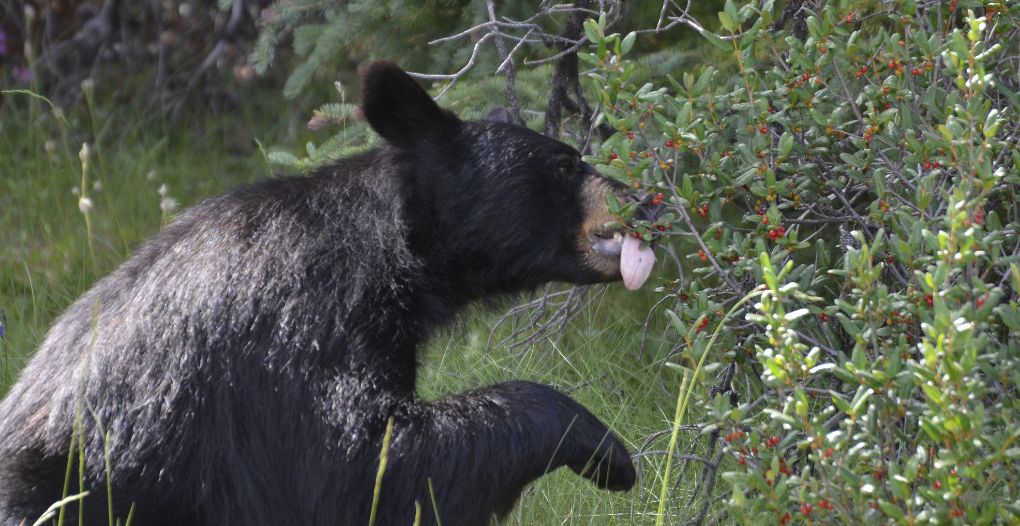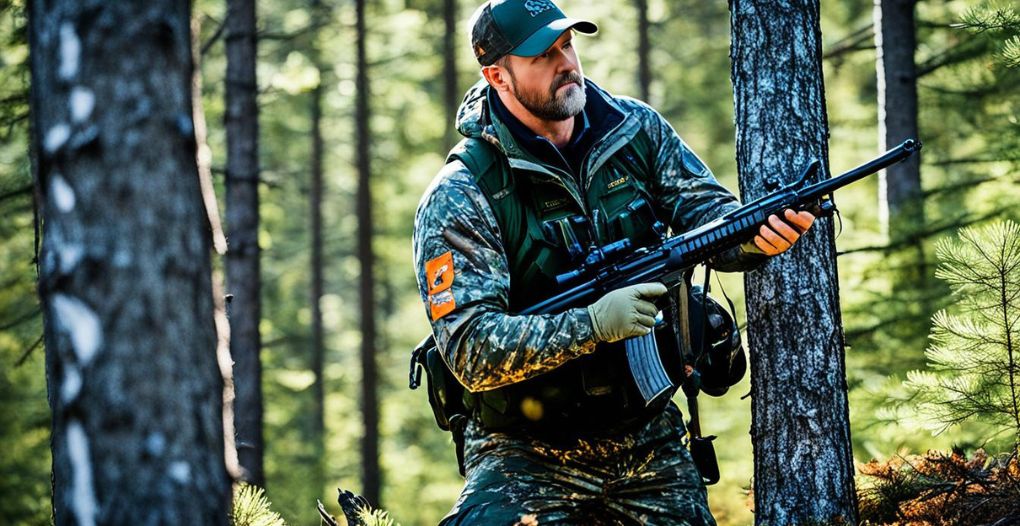For those who hunt black bears, it’s key to know their behaviour and where they live. In Canada, these amazing animals call the wilderness home. Learning about their ways can make hunting safer and more successful. Knowing where they live helps hunters find where they might be. It also means following important safety rules.
This guide is for hunters in Canada. It aims to teach them how to interact with wildlife with respect. It also helps improve their hunting skills.
Introduction to Black Bears
Black bears, known scientifically as Ursus americanus, are a common bear type in North America. They live in many places in Canada, like forests, mountains, and even near cities. This lets them find food and shelter easily.
Black bears are key to their ecosystems. They help by spreading seeds in their droppings, which keeps forests and meadows healthy. Learning about Ursus americanus helps us manage wildlife well, keeping their numbers stable.
In Canada, black bears are quite different from other bears like grizzly and polar bears. Knowing these differences can make hunting better and help with smart choices in the wild.

Understanding Black Bear Behavior
Black bears show a wide range of behaviors shaped by their social lives, what they eat, and the seasons. These factors help us understand their complex lives and how they interact with their surroundings.
Social Structures and Interactions
Black bears have different social behaviors, depending on who they are and where they live. Most of the time, they like to be alone. But when they do meet, it can be interesting. Mothers teach their cubs how to survive for up to two years.
Adult males travel far to find a mate, leading to some exciting meetings among bears.
Feeding Patterns and Diet
Black bears eat a wide variety of foods, showing how adaptable they are. They eat plants, insects, and small mammals. Knowing what they eat is important, especially for hunters who need to know where to find them.
In spring, they eat new plants. Summer brings berries, nuts, and carrion. Understanding their eating habits can help hunters be more successful.
Seasonal Behavior Changes
Seasons change how black bears behave. As winter comes, they eat a lot to build up fat reserves. This means they eat more, taking in lots of calories.
In spring, after waking up from hibernation, they look for food to refill their energy. Knowing these changes can help hunters find the best times to hunt black bears.

Black Bear Habitat Preferences
Knowing where black bears live is key for those who want to see or hunt them. Their choice of home affects their food, safety, and how they interact with humans.
Typical Locations and Terrain
Black bears live in many places, picking spots that meet their needs. You can find them in:
- Forested areas, especially mixed deciduous and coniferous woods
- Mountainous regions where steep inclines offer shelter
- Swamps and wetlands rich in food sources
- Meadows that provide safe foraging opportunities
The terrain they choose is important for their survival. They like places with cover, food, and water. This helps them stay safe and find what they need to eat.
Preferred Vegetation Types
What plants are around affects where black bears live and how they act. They go for areas with:
- Berries, such as blueberries and blackberries during the late summer
- Nuts from trees like oaks and hickories in the fall
- Herbaceous plants providing crucial nutrients in spring
- Fruits from shrubs and trees throughout the growing season
These plants help the bears stay healthy and strong. They affect how bears move and interact with each other.
Black Bear Behavior and Habitat for Hunters in Canada
Knowing how black bears behave and where they live is key to hunting them in Canada. These animals have certain ways of eating and moving that can change a hunter’s plan.
Black bears like places with lots of cover and food. They go to areas with lots of berries, acorns, and different plants. As the seasons change, what they eat changes too. It’s important to watch their activity closely. This helps hunters plan their hunts during the best times, like spring and early autumn.

Essential Tips for Hunting Black Bears
Successful hunting is all about skill, knowledge, and planning. Understanding bear scent trails and knowing the best times to hunt can really help. Good scouting techniques also make you ready for the wild.
Understanding Scent Trails and Tracks
Black bears use their smell a lot, so scent trails are key. Look for paths to food sources where bears often go. Signs include:
- Bare patches of soil indicating digging.
- Tracks with unique claw marks.
- Scat showing what they eat.
These signs help you scout and understand a bear’s territory. Watching these trails over time shows patterns. This helps improve your hunting plan.
Appropriate Hunting Times
Picking the right time to hunt is crucial. Black bears have certain times they’re most active. Early mornings and late evenings are best for finding them near food. Being quiet and patient can increase your chances of spotting them.

Safety Precautions When Hunting
Staying safe while hunting in black bear territory is crucial for all hunters. Using bear avoidance strategies can lower the risk of unexpected bear meetings. Following safety steps helps protect hunters and keeps bear populations and their homes safe.
Avoiding Bear Encounters
To keep hunting safe, it’s best to avoid bears in the first place. Here are some tips to help:
- Hike with friends to make noise and scare bears away.
- Don’t hunt at dawn or dusk when bears are most active.
- Stick to marked trails and avoid places where bears might hide.
- Keep food and things that attract bears away from where you sleep.
- Use bear-proof containers for food and throw away trash properly.
What to Do If You Encounter a Bear
Even with precautions, you might still meet a bear. Knowing how to act is key:
- Stay calm and slowly back away from the bear while facing it.
- Talk to the bear in a loud voice to let it know you’re there.
- If it’s a black bear, stand your ground. Don’t climb trees or pretend to be dead.
- Look big by raising your arms or your backpack.
- If a bear charges, stand firm. It might just be pretending and will likely go away.
Impact of Climate on Black Bear Behavior
The impact of climate on black bears is clear as their homes and ways change. Warming temperatures and changing weather patterns make them change their yearly activities and how they find food. Climate change is changing the natural world, making food availability change a lot from year to year. This is why it’s important for hunters to know about these changes when planning their trips.
Climate affects food availability a lot. For example, if spring comes early because it’s warmer, bears can start looking for food sooner. But, too much heat or late frosts can make it hard to find food, forcing bears to look further. These changes mean hunters need to change their plans to catch up with the bears.
Also, climate changes can change where bears live and how healthy they are. As their homes change, bears will have to get used to new conditions. This could change how they behave and how they interact with other animals. It’s important for hunters to keep up with these changes. This way, they can help protect bears for the future.

In summary, understanding black bear behavior and habitat is crucial for successful and safe hunting in Canada. By familiarizing yourself with their habits, preferred locations, and the impact of seasonal changes, you can significantly improve your hunting strategy. Always remember to hunt with respect for wildlife and stay informed about local regulations to ensure a responsible and rewarding hunting experience.
At Garia Bay Outfitters, we’re here to make your black bear hunting trips unforgettable. With top-notch gear and expert advice, we ensure every outing is successful. Trust us for all your hunting needs.

